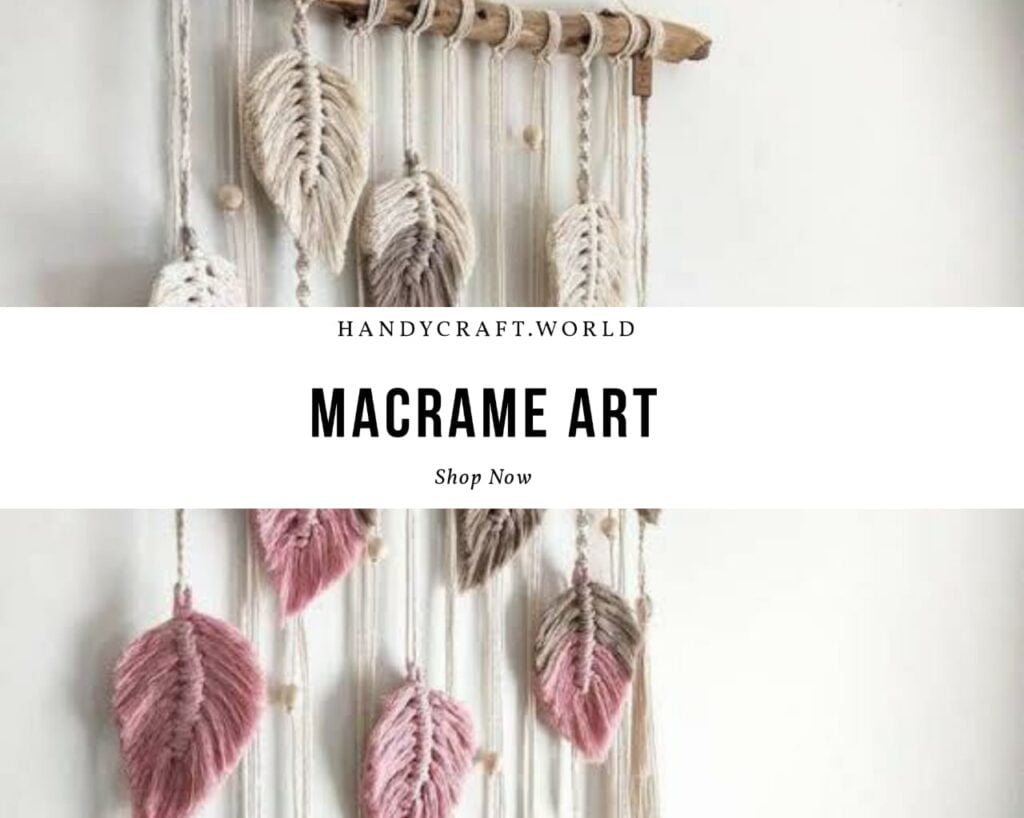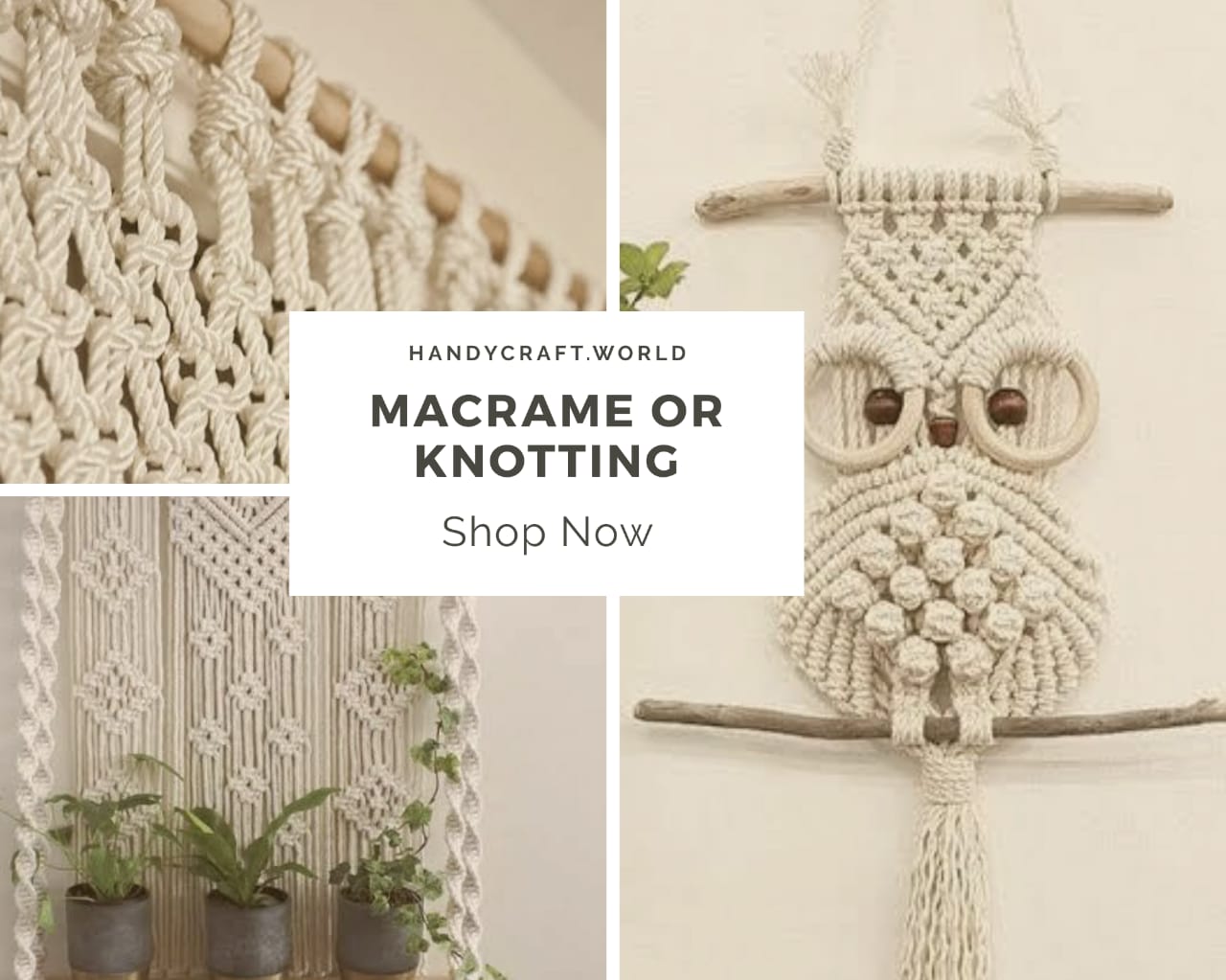Contents showMacrame Art
Macrame Art can transform simple things into extraordinary ones. Just like a long piece of cloth wrapped gracefully makes you look gorgeous that we name ‘A Saree’ similarly, a simple rope that was actually a fibre art which is now resurfaced to form a modern craft called- Macramé.
As an art lover, I truely believe that, artists weave magic through their hands. They put a spell on you and you can’t help but go all mesmerized with what they create. Macrame art did the same to me when I came to know about it at the first place. I’ve always found myself attracted to all forms of art respective of their times they’ve been created and how! Macrame Art never fails to awake that gypsy soul in me and give those Bohemian Vibes that makes me revive that urge to travel the world, explore and know more about such art-forms.
Introduction
Macrame Art—or Knotting—is one of many crafts being revived by those who love working with their hands. Just like surface embroidery, quilting, and needlework are seeing a bump in popularity, macrame art is being transformed from a 1970s relic into a hot, trendy art form.
A versatile sort of fibre art, macrame art are often wont to make everything from wall hangings and plant hangers to jewellery, purses, and even clothing items. Using simple materials like cotton twine, jute, hemp, or yarn, macrame art is often as simple or complex because the crafter would really like. Embellishments like glass or wooden beads, also as dyed threads, also can open up a variety of creative possibilities.
History
Macrame’s roots are actually quite interesting, with a history dating back thousands of years. Some believe that the term comes from the 13th-century Arabic word migramah, which means “fringe.” Others believe its origins lie in the Turkish word Macramé, which refers to “napkin” or “towel,” and was a way to secure pieces of weaving by using excess threads along the top or bottom of woven fabrics.
Either way, decorative macrame designs actually first appears in carvings by the Babylonians and Assyrians that depict fringed braiding used to adorn costumes. In the 13th century, Arab weavers used decorative macrame knots to finish the excess thread on shawls, veils, and towels. It then spread to Europe via North Africa, when the Moors brought macrame designs to Spain.
While most think of macrame art as a craze of the 1970s, the craft reached peak popularity in Victorian England. First introduced to England in the late 17th century, Queen Mary herself taught classes to her ladies-in-waiting. Most Victorian homes had some type of Macrame Paintings decoration, as it was used not only to decorate clothing, but also as curtains, tablecloths, and bedspreads.
Knotting Materials
Some samples of cords which will be utilised in Macrame Paintings include:
- Rayon
- Nylon
- Silk
- Waxed cotton
- Hemp
- Plastic
- Polypropylene
- Rat-tail
- Leather
- Suede
- Wool
- Embroidery thread
- Crochet thread
When choosing which material to use for a project it is important to think about what the finished item is and how it will be used as some will be more practical or suitable than others. Often stiff thick cords aren’t the simplest choice for creating jewellery but they might be ideal for a sack which will got to carry some weight and not fray or wear easily. If several sorts of cord would be suitable for a project they’ll end in quite different finished items.
A bracelet design made using fine cotton cord is going to be softer, lighter and more discrete than an equivalent piece made employing a thicker leather cord for instance. Another thing to consider in relation to the thickness of cords is how easy they will be to use. Thicker cords are often easier but some types are difficult to stay the macrame knots in situ once they are thick. Thin cords are often fiddly and slow to figure with but the finished results are often stunning and really detailed.

The Hustle in Projecting & Sizing
The exact dimensions of any finished project can vary counting on the cords used and now tightly or loosely the macrame knots are tied. Each person will knot with different tension and the majority of macrame art projects allow for this by being generous with the cord required. This difference in knotting also can cause variations within the size of the finished project. Measure your piece as you work and if needed adjust the number of macrame knots or try to tie them tighter or less tight.
Several factors can influence how difficult a macrame art project is going to be to finish. The size of a finished project can make them harder but this is often not always true. Some large projects such as plant holders and bags maybe are large but are made using only a few or basic macrame knots.
The number or sort of macrame knots may cause a design to be more complicated to finish especially if there are tons of design changes or switching between knot types. Another factor to consider related to the difficulty is the thickness of the cords used. Thinner cord diameters are often harder to knot with, tend to use longer lengths of cord (as smaller macrame knots are produced each time) and are more time-consuming.
Then & Now
Macrame Designs has been around for hundreds of years and is thought to have originated in the 1200s with Arab weavers. The true art of macrame designs is very detailed and done by hand, not a machine. The trend of creating macrame designs drifted in and out of popularity but most prominently became popular in the 1970s and, again, in the 21st century.
1970’s
Macrame Art was a huge part of the hippies & bohemian culture and was seen in both decor and fashion. It was a staple in homes across the country in the form of tablecloths, wall hangings, and plant hangers. The most popular craft of the time was wall hangings. Most were used for decor, but some were also functional. An example of a functional Macrame Designs wall hangings can be seen below. It is a message centre that was used to hold a writing utensil and paper for leaving written messages as well as a hand towel. It was the perfect addition to any kitchen or great to have wall hanging close to a telephone.
21st Century
In the 1980s, macrame art began to dissolve as a trend and didn’t come into style until recent years. It is now a staple in trendy home decor across America and may be seen in most decor retailers. It comes during a sort of colours, sizes, materials, and macrame knots and may incorporate decorative beads also as mirrors and other functional objects. The most common material that macrame designs are formed with is a twisted cotton rope. Cotton rope is great for this craft because it’s soft and straightforward to figure with. It is also easily dyed giving the choice of colour to crafters.
You cannot really call yourself a free spirit unless and until you have that urge to have one or other Macrame Designs with you, in any form it may be. For your home decor, wall hangings for yourself or making it as a reflection of your preferences as an art lover by gifting them the Macrame Designs itself.
We can help | Shop @ HandyCraft.World for a wide range and varieties of Macrame Designs and other art-forms specially handcrafted for you.




